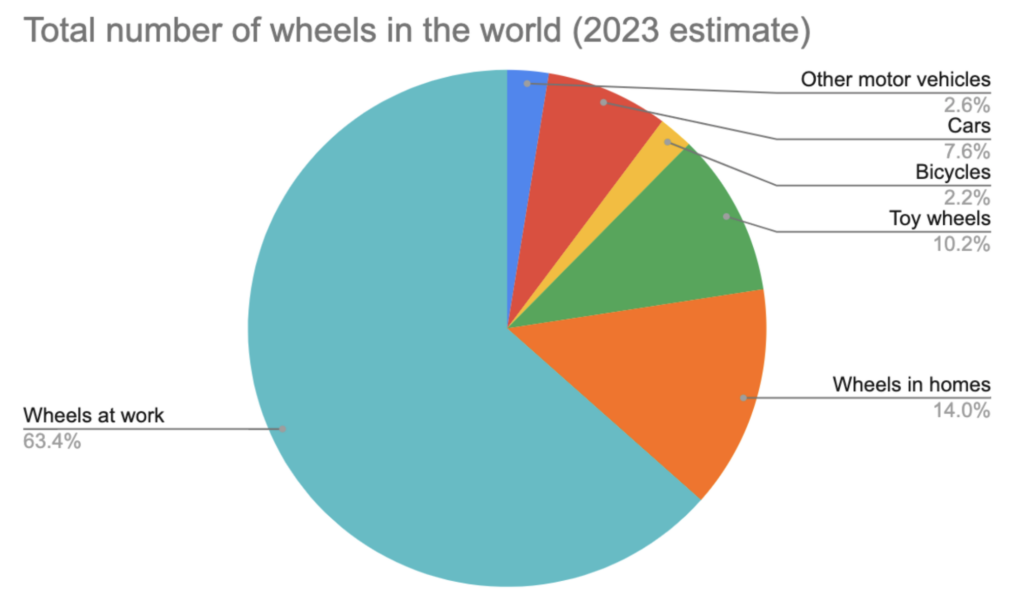
How Many Wheels Are in the World
How Many Wheels Are in the World When you stop for a moment and really think about it, the question “How many wheels are in the world?” sounds both simple and complex at the same time. We see wheels every single day—on cars, bikes, trolleys, and even on office chairs—but have you ever tried to imagine adding them all up? The number is almost impossible to calculate precisely, yet that doesn’t stop experts, enthusiasts, and even curious internet communities from speculating. Let’s dive into this fascinating topic and break down just how massive the world of wheels truly is.
Why the Question Captures Our Imagination
The first reason this question fascinates people is because wheels are literally everywhere. From a child’s toy truck to a jumbo jet, How Many Wheels Are in the World a basic yet powerful invention that shape modern life. Asking “how many wheels exist” is a fun thought experiment because it blends math, engineering, and human curiosity.
There’s also a social angle to it. In 2022, the internet exploded with debates like “Are there more wheels or doors How Many Wheels Are in the World?” and suddenly everyone was trying to prove their point. Wheels became the star of the conversation, and people began listing out all the possible sources of wheels we overlook daily. It showed how a simple question could spark widespread curiosity and discussion.
On a deeper level, this kind of question also highlights how interconnected How Many Wheels Are in the World is. Every time a new car rolls off the production line, thousands of new wheels join the global count. Similarly, when factories mass-produce toys, strollers, or suitcases, they quietly contribute to a global “wheel population” that nobody really tracks.
The Dominance of Automobile Wheels

If we’re talking numbers, cars are easily the biggest contributor to the global wheel count. According to industry data, there are over 1.4 billion cars How Many Wheels Are in the World, and each one usually comes with at least four wheels. That means car How Many Wheels Are in the World alone make up over 5.6 billion wheels worldwide. And this doesn’t even include spare tires, trailers, or modified vehicles with more than the standard four wheels.
Then you have trucks, buses, and other heavy vehicles. A large truck can have anywhere from 6 to 18 wheels depending on its size and purpose. Multiply that by the millions of trucks operating globally, and the number skyrockets even further. It’s safe to say that automotive industries account for the majority of wheels on Earth.
But it’s not just about the present; cars also keep adding to the future count. With millions of new vehicles being manufactured every year, the wheel population keeps expanding rapidly. The automotive sector alone makes it almost impossible to give an exact number because the total increases every single day.
Bicycles, Motorcycles, and Smaller Vehicles
While cars dominate, bicycles and motorcycles contribute significantly to the wheel count too. Did you know there are more than 1 billion bicycles in How Many Wheels Are in the World? That’s at least 2 billion wheels right there. And when you add motorcycles, which number over 200 million globally, the figures grow even more impressive.
What’s interesting is that bicycles often come with additional wheels when you factor in training wheels for kids. That means a single bike for a child could add four wheels instead of the usual two. In developing countries, where bicycles remain a primary form of transportation, their contribution to the world’s wheel tally is enormous.
Motorcycles, scooters, and mopeds add another layer. With urban areas increasingly turning to two-wheelers for convenience, their share of the wheel count keeps rising. Plus, don’t forget electric scooters and e-bikes, which have gained popularity in recent years. Each of these categories adds millions upon millions of new How Many Wheels Are in the World every year.
Hidden Sources of Wheels We Overlook
Most people think of cars and bikes when they hear the word “wheel,” but that’s only scratching the surface. Wheels hide in some of the most unexpected places in everyday life. Take office chairs, for example—nearly every swivel chair has five small wheels. Imagine how many office chairs exist in businesses, schools, and homes around the world, and suddenly that’s billions more wheels in the global count.
Another overlooked source is suitcases. Travel luggage almost always comes with two to four wheels these days. With air travel booming, billions of bags have been manufactured in the last few decades, each quietly adding to How Many Wheels Are in the World wheel supply.
Then there are toys. Think about Hot Wheels, toy trucks, and Lego sets. A single box of toy cars might contain a dozen wheels, and given how many toys are made every year, this category alone could rival the number of automobile wheels. These small wheels may not seem significant individually, but collectively, they create an enormous impact.
Industrial and Specialized Wheels
Outside of everyday consumer items, the industrial world also contributes massively to the wheel population. Factories use conveyor belts, many of which rely on small wheels or rollers to move goods efficiently. Airports use luggage carts, aircrafts rely on multiple landing gear wheels, and warehouses operate forklifts and pallet jacks—all loaded with wheels.
Even construction equipment is wheel-heavy. Bulldozers, cranes, tractors, and other machinery often feature giant How Many Wheels Are in the World or multiple smaller ones working in tandem. These specialized wheels are not as numerous as car wheels, but their sheer size and importance make them stand out.
Another fascinating area is rail transport. While trains don’t technically use “wheels” in the same way cars do, their metal wheels on tracks still count. Given the number of train cars and subway systems operating worldwide, that’s millions more wheels we can’t ignore.
Estimating the Total Wheel Count
So, how many wheels are in the world? The truth is, we don’t have an exact number—and probably never will. However, based on estimates from cars, bicycles, motorcycles, toys, office furniture, and industrial uses, it’s safe to assume the number is in the tens of billions, if not higher. If we simply add up known quantities, cars alone contribute around 5.6 billion wheels, bicycles add another 2 billion wheels, and motorcycles or scooters account for nearly 400 million wheels. Beyond that, there are countless office chairs, toys, suitcases, industrial machines, and specialized equipment, each adding tens of billions more to the tally.
This means the total number of wheels is almost unimaginably high, and because new ones are being manufactured at a staggering pace every single day, the figure only keeps growing. The fun part is that nobody can pin down a final number with certainty. Every calculation remains speculative, but that’s exactly what makes the question so intriguing. It sparks debate, fuels discussion, and ignites curiosity—just like any great thought experiment should.
Why This Question Matters More Than You Think
At first glance, asking how many How Many Wheels Are in the World exist might seem like a trivial game. But it’s actually a window into the scale of global manufacturing and human innovation. Wheels symbolize progress—without them, modern life would grind to a halt. From transportation to technology, they quietly power nearly everything we do.
On a cultural level, questions like these remind us how interconnected our world is. A child’s toy car in one part of the globe shares something in common with a massive cargo truck in another: both rely on How Many Wheels Are in the World to function. It’s a small but meaningful reminder of how universal certain inventions are.
Finally, this question taps into the human love for numbers and scale. We’re fascinated by “biggest,” “largest,” and “most” kinds of records. Even if we’ll never know the exact wheel count, imagining it encourages us to see the everyday objects around us in a new light.
Final Thoughts
So, how many wheels are in the world? The answer is—more than we could ever count. From cars and bicycles to office chairs and toys, wheels are everywhere, silently multiplying in ways we rarely notice. The total number easily sits in the tens of billions, and it continues to rise every day as factories churn out new products.
While we may never land on an exact figure, what matters more is the journey of exploration the question inspires. It makes us look at the world differently and appreciate how a seemingly simple invention has shaped human history. Next time you roll your suitcase, sit in your chair, or drive your car, remember—you’re adding to one of the biggest and most fascinating counts on Earth.


